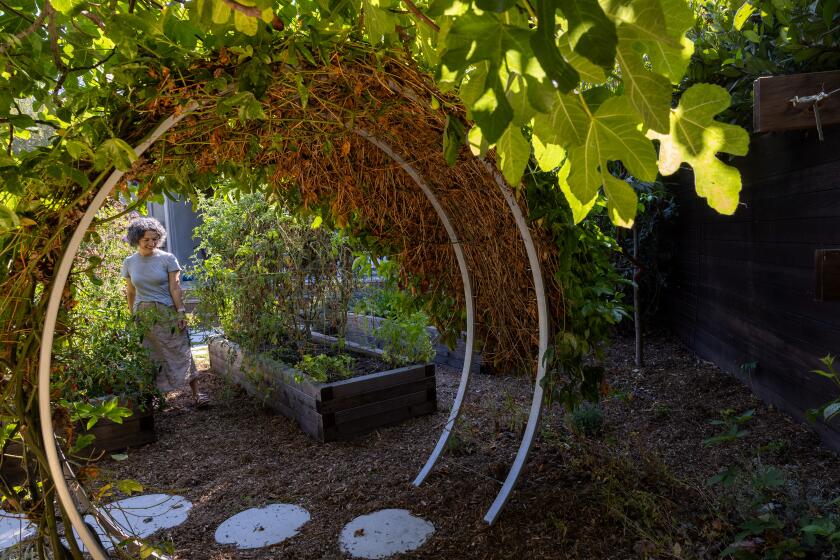Taking the season in strides
Orcutt Ranch Horticulture Center
23600 Roscoe Blvd., Canoga Park,
(818) 883-6641
www.laparks.org/dos/horticulture/orcuttranch.htm.
LOCALS come to pick citrus in the summer and fall, but to some this 24-acre ranch is best in winter, when it’s cooler, calmer and more quiet, like the vacation home in the country it used to be.
William Warren Orcutt, the oil company geologist credited for the early removal and research of fossils at the La Brea Tar Pits a century ago, called this place Rancho Sombra del Roble, or Ranch in the Shade of the Oak. And indeed, the namesake trees of his home -- now a city park -- scatter their mottled leaves like a million puzzle pieces across the orchard floor.
Linger an hour under their canopies this time of year, and you may encounter only one or two other visitors. A friendly staff member suggests a walk along the nature trail. When the sun comes through the trees just so, she says, it’s absolutely beautiful. And she’s right.
But what really conveys the landscape’s early ranch roots and present-day charm are the citrus. In a single tree, Valencias dangle in shades of newborn green, adolescent yellow and the squirrels’ favorite, sweet orange. In another grove, the clean scent of grapefruit brightens the air, and clusters of golden globes hang so heavy you could pick breakfast sitting down.
The next harvest isn’t until July. Until then, there’s a piece of L.A.’s past, ripe for the picking.
-- Craig Nakano
*
The Iron Garden
25850 Wayne Drive, Idyllwild. Open daily until dusk. Donation box on premises.
AT the Iron Garden, ringing in the new year is taken seriously. At the half-acre terraced property, which takes its name from owner Arnold Jorgenson’s collection of vintage metal tools and conveyances, visitors enter through an iron gate and walk through Liberty Bell Lane, a series of archways crowned with iron instruments.
“It’s a family tradition to ring all the bells on New Year’s Eve,” says Doris Jorgenson Valentine, daughter of the late Norwegian who, from 1949 to 1970, built the garden.
Nestled in a grove of cedar and pine, the property is starkly beautiful in winter, a sculpture park of industrial designs. Dusted with snow, the Iron Garden looks ancient and mysterious, like a century-old tintype photograph. Jorgenson, a former welder, and his wife, Anna, spent their retirement years traveling with a truck and trailer, collecting a Civil War cannon, old caldrons and sleighs, and a tool used to smash bottles during Prohibition. Artfully arranged vignettes cover logging, farming, shipping, mining and railroading. “It’s a fabulous museum of things from a time when life was not so easy,” says Dan Martin, who serves as the garden’s caretaker.
Indeed, old-fashioned whimsy is at play. Near a fireman’s hat, Smokey Bear is carved from scorched wood, and buildings sport iron hatchets welded into door handles. Tools hang like coats of arms. Some assemblages are so dense they look like the work of sculptor Louise Nevelson.
“My parents’ idea to share it with the public is a wonderful heritage that keeps them and the garden very much alive,” Valentine says. “Visitors always remark that it’s peaceful and mystical, and I have heard people say they’ve seen angels.”
-- David A. Keeps
*
The Mother Center, Self-Realization Fellowship
3880 San Rafael Ave., Los Angeles; (323) 225-2471; www.yogananda-srf.org.
FEW know this little haven is here, let alone how to reach it. But navigate your way through Highland Park, up Mt. Washington and down the long driveway, and you’ll find yourself in a maze of impeccably tended gardens, shaded and serene.
Compared with this spiritual organization’s grand 10-acre Lake Shrine in the Palisades, the landscape at the Mother Center speaks with a voice that’s softer but no less compelling. The late spiritual leader Paramahansa Yogananda, who founded the fellowship’s international headquarters here in 1925 and lived on site for three decades, often held classes in his outdoor “temple of leaves,” where visitors today are invited to come for meditation and reflection.
Pebble-covered paths wend under a canopy of evergreens to private nooks: a seat of hewn rock tucked beside a petite waterfall, a stone table set under 40-foot pines, two benches surrounded by an improbable mix of ferns, cactus and camellias. The net effect is a garden with a peculiar kind of beauty that defies labels. Palms, roses, yuccas, maples, mondo grass -- they’re all part of the mix.
Looking south from a grassy clearing, the view of downtown is magnificent. But soon you’ll find yourself pulled back toward the shady warren of footpaths and its points of introspection. Fifteen minutes quickly turn to 50, and all too soon it’s time to go back to the car, back down the hill and back into the real world.
-- Craig Nakano
*
Wattles Mansion and Gardens
1824 N. Curson Ave., Los Angeles; (323) 874-4005; www.hollywoodheritage.org. Appointment required.
STEPHEN SYLVESTER, executive director of the Wattles Mansion in Hollywood, apologetically warns that the gardens here don’t reach their prime until spring. Yet look around: Pink and red hibiscus are blossoming, oblivious of winter’s chill. Tagetes lemmonii is an effusion of yellow. Lilies are pushing up, and bees are buzzing stands of lavender.
To an out-of-state visitor’s eye, this is spring.
Or fall. Garden walls are draped in ivy, its palm-size leaves mottled green and yellow, the 10-inch stems beginning to blush crimson.
Because the property is rented for weddings and other events year-round, Wattles has been planted to provide perpetual color, says Sylvester, who works for Hollywood Heritage, the nonprofit managing the site. Yes, many plants are dozing in December and January. But just as the roses begin to tire, other flowers perk to life. Bougainvillea blazes with color, and birds of paradise crane their necks south toward the mansion’s arriving guests.
Omaha banker Gurdon Wattles planted several gardens: Japanese, Italian, Mediterranean and a hybrid simply referred to as American -- all of which he occasionally opened to the public.
A walk through the formal gardens takes only 10 minutes; for a longer stretch of the legs, the less-manicured trail of a city park -- once part of Wattles’ 50 acres -- winds higher into the Hollywood Hills. What makes the place special is a sense of Hollywood before it was Hollywood, a time and place where grandeur was expressed without grandiosity. The property celebrates its 100th birthday next year.
Says Sylvester, “It’s a miracle this place has survived.”
-- Craig Nakano
More to Read
Sign up for The Wild
We’ll help you find the best places to hike, bike and run, as well as the perfect silent spots for meditation and yoga.
You may occasionally receive promotional content from the Los Angeles Times.






